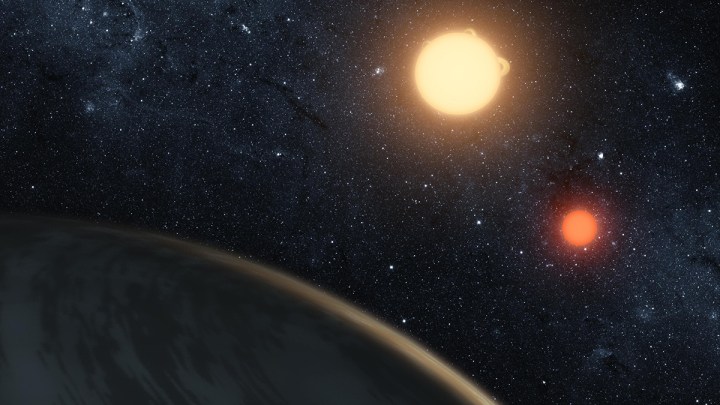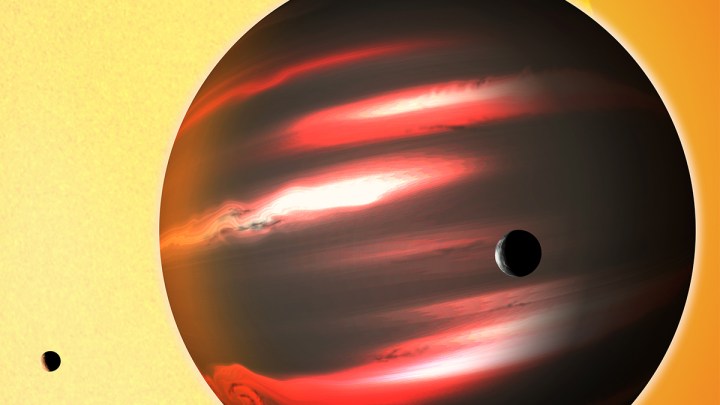
Well if any of those situations sound like you, then this list is worth checking out. So grab your space suit, fuel up the shuttle, and strap in for an intergalactic tour of the best exoplanets that humanity has discovered so far.
#10: TrES-2b — The Dracula Planet

Our first stop is the pitch black planet TrES-2b. This gas giant’s atmosphere is less reflective than coal, but as hot as the hottest Earth-born lava. These two odd properties give the planet an eerie red glow, so if you’re a fan of horror stories and Lovecraftian lore, then this might be the perfect stop for you.
Pros: It’s the perfect setting for any of your spooky Halloween parties or vampire cult get-togethers.
Cons: While the red glow may deliver the spooky vibe you’re after, it will also reduce your party to ash as soon as you arrive.
#9: Kepler-36c/b — That’s no moon!

Second on this journey are the two planets Kepler-36 C and B. These celestial bodies pass by each other at a distance that’s roughly four times the distance between Earth and the Moon — thereby providing a remarkable view of either planet from the other’s surface.
Pros: A beautiful view of either planet as they pass each other like ships in the night.
Cons: This view will likely be your last, as neither planet is anywhere near hospitable.
#8: OGLE-2005-BLG-390 — Love the snow? This one is nicknamed ‘Hoth’

Are you a fan of the snow, always looking for the freshest slope? Then OGLE-2005-BLG-390, nicknamed ‘Hoth’, is the exoplanet for you! At negative 220 degrees Celsius, this planet is in a perpetual deep freeze — presumably creating endless slopes for you to carve up.
Pros: It’s an entire planet of slopes for you and your crew to cruise down on your space skis.
Cons: On the other hand, the lack of atmosphere an precipitation means it’s likely solid ice — just like you’d be shortly after arrival.
#7: PSR B1257+12 system — A light show to die for

The Aurora Borealis is one of Earth’s greatest sights, but it’s a firefly in the night compared to the light shows caused by PSR B1257+12. This pulsar is the remnants of a star gone supernova, which constantly whips the planets around it with tendrils of radiation — causing planet-wide lights in the sky.
Pros: This place boasts the most impressive auroras you’ll ever see.
Cons: Your DNA would immediately be scrambled and fried by the astronomical levels of radiation.
#6: 55 Cancri e — An intergalactic prospector’s dream

Are you a more adventurous type, lusting for the days of old when you could make your fortune on the frontier? Then get your gear together and head to 55 Cancri e, a planet whose composition is largely carbon. This makeup results in the planet being almost entirely made of precious metals, both inside and out.
Pros: The potential to become a space mining tycoon with zillions of blemflarcks (or whatever currency we use in the future)
Cons: All those precious metals are hot as hell and currently in liquid form, so good luck with that!
#5: Kepler-16b — Where your shadow will never be lonely

Kepler-16b itself is not especially interesting, but what it’s orbiting definitely is. This exoplanet orbits two stars. That’s right folks, not one, but TWO stars. Look forward to never before seen sunsets and sunrises, and a pal for your shadow.
Pros: A one in a million sky. Woo any potential partner with a romantic picnic beneath a double sunset.
Cons: Unfortunately the planet itself is VERY cold, even with two stars. Let’s just say you’re going to need a LOT of picnic blankets.
#4: Wasp 12 b — A crumbling planet being eaten by its sun

For those of you looking for a bit more of an extreme sightseeing experience, Wasp 12 b is everything you could ask for. This planet is slowly being “eaten” by its star, and the side facing the star is crumbling and forming a ring of debris along its orbit. If you’re into those high budget scenes in apocalypse movies, you’re going to LOVE this.
Pros: Probably the most metal thing you will ever see in your life.
Cons: This should be obvious, but if the planet is dissolving, you’re not going to do too well yourself.
#3: Kepler-452b — Earth’s bigger, older cousin

So death defying sights and experiences aren’t your thing, and you’re looking for a new place or a summer home? Welcome to Kepler-452b: Earth’s bigger, older cousin. With a 385 day orbit, a rocky exterior, and 60% more mass than Earth; it’s a new frontier that’s both vast and vaguely familiar.
Pros: Finding your own special place won’t be hard with all this space, and the years are just about the same length as Earth’s.
Cons: Aside from that, the place is pretty boring. As far as we know, it’s the only planet orbiting this star, and has no moons. It’s also 1400 light years away, so say goodbye to your fam here on Earth.
#2: Proxima B — Only a hop, skip, and four light years away

Unlike our last home away from home, Proxima B orbits Proxima Centauri: the closest star to our Sun, which sits just a few short light years away. With a rocky red exterior like our neighbor Mars and a member of the infamous Alpha Centauri system, this could be your summer getaway to your own red skied paradise.
Pros: It’s only four light years away, making it the best candidate for potential colonization. There’s also a red landscape that gives it that homey Mars feel, and multiple nearby stars in the sky,.
Cons: Unfortunately, signs for this planet being habitable are slim. Its star is old and radioactive, and its orbit takes only 11 days. Not to mention that it is likely tidally locked like our moon. Bummer.
#1: Trappist-1 System — A fistfull of Earths

Welcome to the Trappist-1 system, seven tightly bundled planets orbiting an ultra-cool dwarf star, and are all suspected to harbor rocky surfaces. Due to the nature of this system’s sun, it’s possible that the majority of these planets harbor liquid water as well — making this system a treasure trove of habitable planets.
If that isn’t enough to wet your whistle, these planets are also VERY close to each other. Close enough that while standing on any of them, other planets would be near enough that you could see clouds and large geological features with your naked eyes.
As most of these planets are potentially habitable, you’d get your pick of the litter when it comes time to settle down and build a colony. For these reasons, the Trappist-1 system comes thundering into first place on our list of Top Ten Exoplanets.
Pros: Multiple planets to settle, liquid water, non gaseous planets, and close interplanetary proximity. It also has a really neat sky, and isn’t near anything that’s going to kill you — like a black hole or a radiation-spewing pulsar.
Cons: Two big things: this system is 39 light years away, and it’s suspected that all of these planets are tidally locked due to their proximity to their star — meaning the weather on each planet would be wildly unlike Earth’s.



